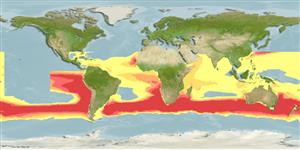Common names from other countries
>
Zeiformes (Dories) >
Oreosomatidae (Oreos) > Oreosomatinae
Etymology: Allocyttus: Greek, allos = other + Greek, kyttaros, kytos = a convex cavity.
Environment: milieu / climate zone / depth range / distribution range
นิเวศวิทยา
เกี่ยวกับทะเล,น้ำเค็ม สัตว์ผิวน้ำในเขตน้ำลึก; สัตว์น้ำที่อาศัยและอพยพภายในทะเลเท่านั้น (Ref. 51243); ระดับความลึก 0 - 1800 m (Ref. 50610), usually 800 - 1200 m (Ref. 6545). Deep-water; 28°N - 58°S
Eastern Atlantic: off Mauritania, Gulf of Guinea, Namibia and South Africa. Western Atlantic: off Suriname, southern Brazil and Uruguay. Western Indian Ocean: Mozambique Channel, Walters Bank. Eastern Indian Ocean: East Indian and West Australian Ridge, Australia. South Pacific: New Zealand and off Chile. Records from the North Pacific belong to Allocyttus folletti. Also Ref. 26139).
Length at first maturity / ขนาด / น้ำหนัก / Age
Maturity: Lm 28.0, range 23 - ? cm
Max length : 42.5 cm TL เพศผู้/กระเทย; (Ref. 27159); น้ำหนักสูงสุดที่มีการรายงาน: 2.0 kg (Ref. 27124); อายุสูงสุดที่ได้รายงาน: 140 ปี (Ref. 39383)
เงี่ยงครีบหลัง (รวม) : 5 - 8; ก้านครีบอ่อนที่หาง (รวม) : 28 - 33; เงี่ยงครีบก้น: 2 - 3; ก้านครีบอ่อนที่ก้น: 26 - 31. Adults blackish black in color; prejuveniles silvery, back greenish with large grey blotches that disappears at about 12 cm (Ref. 6548).
Occurs on the continental slope (Ref. 9563), forming large shoals over rough ground near pinnacles and canyons (Ref. 6390). Juveniles are pelagic and inhabit oceanic waters in depths of less than 1000 m (Ref. 27230). They tend to be dispersed over smooth grounds (Ref. 6390). Feeds on shrimps, cephalopods, and fishes (Ref. 6548). The eggs float near the sea surface and the larvae also inhabit surface waters (Ref. 6390). Trawl catch rates for warty oreos, and for oreos in general, show no evidence of vertical migration during day or night (Ref. 27150), even though many of the planktonic species consumed by this species undergo daily migrations within the water column (Ref. 6390).
Life cycle and mating behavior
Maturities | การสืบพันธุ์ | Spawnings | Egg(s) | Fecundities | ตัวอ่อน
Displays seasonally synchronised reproduction.
Karrer, C., 1990. Oreosomatidae. p. 637-640. In J.C. Quero, J.C. Hureau, C. Karrer, A. Post and L. Saldanha (eds.) Check-list of the fishes of the eastern tropical Atlantic (CLOFETA). JNICT, Lisbon; SEI, Paris; and UNESCO, Paris. Vol. 2. (Ref. 6545)
IUCN Red List Status (Ref. 130435)
CITES (Ref. 128078)
Not Evaluated
Threat to humans
Harmless
Human uses
การประมง: มีการค้าเพียงเล็กน้อย
เครื่องมือ
Special reports
Download XML
แหล่งที่มาจากอินเตอร์เน็ต
Estimates based on models
Preferred temperature (Ref.
115969): 3.4 - 6.9, mean 4.9 (based on 252 cells).
Phylogenetic diversity index (Ref.
82804): PD
50 = 0.5635 [Uniqueness, from 0.5 = low to 2.0 = high].
Bayesian length-weight: a=0.01380 (0.00803 - 0.02372), b=3.05 (2.89 - 3.21), in cm Total Length, based on LWR estimates for this species & (Sub)family-body (Ref.
93245).
ระดับชั้นอาหาร (Ref.
69278): 4.2 ±0.73 se; based on food items.
ความสามารถในการกลับคืนสู่ปกติ (Ref.
120179): ต่ำมาก, เวลาต่ำสุดที่จะทำให้ประชากรเพิ่มขึ้นเป็น 2 เท่าใช้เวลามากกว่า 14 ปี (tmax=140).
Fishing Vulnerability (Ref.
59153): High to very high vulnerability (68 of 100).
